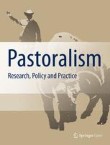2022 Citation Impact
2.5 - 2-year Impact Factor
2.9 - 5-year Impact Factor
1.479 - SNIP (Source Normalized Impact per Paper)
0.719 - SJR (SCImago Journal Rank)
2023 Speed
28 days submission to first editorial decision for all manuscripts (Median)
145 days submission to accept (Median)
2023 Usage
457,229 downloads
153 Altmetric mentions
